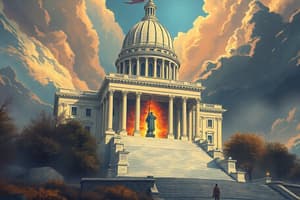Podcast
Questions and Answers
What principle of government emphasizes that power belongs to the people?
What principle of government emphasizes that power belongs to the people?
- Judicial Review
- Separation of Powers
- Federalism
- Popular Sovereignty (correct)
Which branch of government is responsible for making laws?
Which branch of government is responsible for making laws?
- Judicial
- Executive
- Legislative (correct)
- Bureaucratic
What is required for an amendment to be added to the Constitution?
What is required for an amendment to be added to the Constitution?
- Majority petition from citizens
- Unanimous consent from all states
- 2/3 of Congress and 3/4 of states (correct)
- Simple majority in both houses of Congress
Which group opposed the ratification of the Constitution over concerns about individual rights?
Which group opposed the ratification of the Constitution over concerns about individual rights?
Which process was utilized to address the contentious issue of representation of enslaved individuals in the government?
Which process was utilized to address the contentious issue of representation of enslaved individuals in the government?
Which principle of government specifically refers to the division of responsibilities among different branches?
Which principle of government specifically refers to the division of responsibilities among different branches?
Which group was primarily concerned about the potential for a strong central government undermining individual liberties?
Which group was primarily concerned about the potential for a strong central government undermining individual liberties?
What was the minimum number of states required for ratification of the Constitution?
What was the minimum number of states required for ratification of the Constitution?
What does the process of checks and balances ensure within the government?
What does the process of checks and balances ensure within the government?
What was the significance of the Bill of Rights ratified in 1791?
What was the significance of the Bill of Rights ratified in 1791?
Flashcards
Popular Sovereignty
Popular Sovereignty
Government power comes from the people.
Separation of Powers
Separation of Powers
Dividing government power among the three branches (legislative, executive, judicial).
Federalism
Federalism
Power sharing between national and state governments.
Checks and Balances
Checks and Balances
Each branch of government limits the others' powers.
Signup and view all the flashcards
Bill of Rights
Bill of Rights
First 10 amendments protecting individual rights.
Signup and view all the flashcards
Republic
Republic
A system of government where elected representatives make decisions on behalf of the people.
Signup and view all the flashcards
Legislative Branch
Legislative Branch
The branch of government responsible for making laws. It consists of Congress, which has two parts: the House of Representatives and the Senate.
Signup and view all the flashcards
Executive Branch
Executive Branch
The branch of government responsible for enforcing laws. The President and Vice President lead this branch.
Signup and view all the flashcards
Judicial Branch
Judicial Branch
The branch of government responsible for interpreting laws. This branch is made up of the courts.
Signup and view all the flashcards
Three-Fifths Compromise
Three-Fifths Compromise
A compromise made during the Constitutional Convention that counted enslaved people as three-fifths of a person for purposes of representation in the House of Representatives and taxation.
Signup and view all the flashcardsStudy Notes
Slavery Issues
- The Three-Fifths Compromise allowed slave trade to continue until 1807.
- This compromise had specific characteristics.
Structure of the New Government
Principles of Government
- Popular Sovereignty: Power belongs to the people, and they vote.
- Republicanism: Elected representatives represent the people.
- Federalism: Division of power between state and national governments.
- Separation of Powers: Three branches of government (Legislative, Executive, Judicial).
- Legislative: Makes laws (Congress).
- Executive: Enforces laws (President).
- Judicial: Interprets laws (courts).
Checks and Balances
- Each branch monitors and limits the powers of other branches.
Amending the Constitution
- Requires a 2/3 vote in Congress and approval by 3/4 of the states.
Ratification and the Bill of Rights
Federalists vs. Anti-Federalists
- Federalists: Supported the Constitution, ratification, and believed individual rights were protected.
- Anti-Federalists: Opposed ratification and demanded a Bill of Rights to protect individual rights.
- Key Authors: Alexander Hamilton, James Madison, John Jay.
Ratification Process
- 9 of 13 states needed to ratify the Constitution.
- First state: Delaware, Ninth state: New Hampshire, Last state: Rhode Island.
Bill of Rights (1791)
- First 10 Amendments to the Constitution.
- Protect individual liberties.
Studying That Suits You
Use AI to generate personalized quizzes and flashcards to suit your learning preferences.




